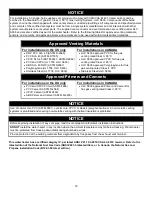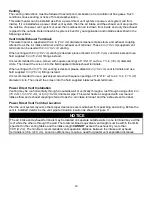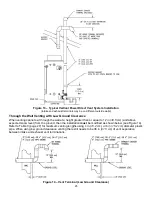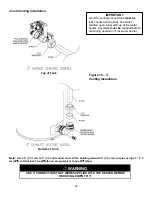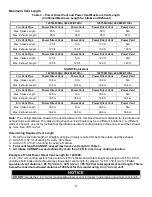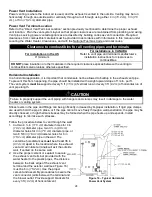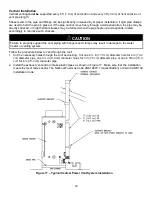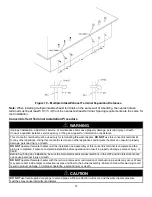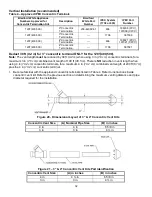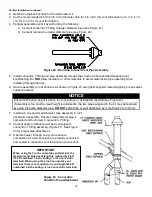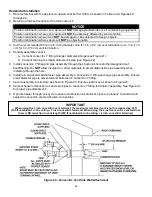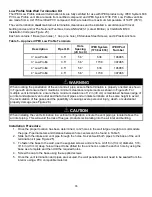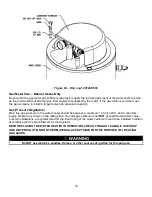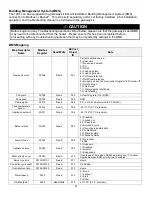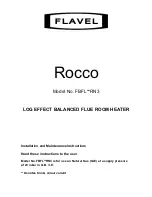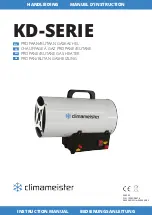
28
Power Vent Installation
Power venting is where the indoor air is used, and the exhaust is vented to the outside. Venting may be run
horizontally through an outside wall or vertically through a roof through using either 4 in (
10.2 cm
), 3 in
(7.6
cm),
or 6 in (
15.2 cm
) diameter pipe.
Power Vent Terminal Location
Refer to the “Direct Vent Terminal Location” section previously mentioned to determine the proper exhaust
vent location. Plan the vent system layout so that proper clearances are maintained from plumbing and wiring.
Vent pipes serving power vented appliances are classified by building codes as vent connectors. Required
clearances from combustible materials must be provided in accordance with information in this manual under
Locating the Water Heater, Clearances, and with the National Fuel Gas Code and local codes.
Horizontal Installation
In a horizontal application, it is important that condensate not be allowed to buildup in the exhaust vent pipe.
To prevent this from happening, the pipe should be installed with a slight upward slope of 1/4 in. per ft.
The vent system
must be
supported every 5 ft
(1.5 m)
of vertical run and every 3 ft
(.92 m)
of horizontal run of
vent pipe length.
Stress levels in the pipe and fittings can be significantly increased by improper installation. If rigid pipe clamps
are used to hold the pipe in place, or if the pipe cannot move freely through a wall penetration, the pipe may be
directly stressed, or high thermal stresses may be formed when the pipe heats up and expands. Install
accordingly to minimize such stresses.
Follow the procedure below to vent through the wall:
1. Cut two 4 ½ in
(11.5 cm)
diameter holes for 4 in
(10.2 cm
) diameter pipe, two 3 ½ in
(8.9 cm)
diameter holes for 3 in
(7.6 cm)
diameter pipe, or
two 6 5/8 in
(16.9 cm
) diameter holes for 6 in
(
15.2 cm
) diameter pipe in the wall. The
centerline hole distances
must
be at least 36 in
(91.4 cm)
apart in the location where the exhaust
vent and air intake terminals will exit the outside
wall, if vented on the same wall.
2. Use the proper cement or sealant to secure
the exhaust vent terminal provided with the
water heater to the plastic pipes. The distance
between the back edge of the exhaust vent
terminal and the exterior wall (see Figure 16)
must be 6 in
(15.2 cm).
Use the proper
cement and assembly procedures to secure the
vent connector joints between the terminal and
the blower outlet. Provide support brackets for
every 3 ft
(.92 m)
of horizontal vent.
Clearance to combustibles for all venting pipes and terminals
For installations in the US
0” minimum
For installations in CANADA
Refer to vent pipe and terminal manufacturer’s
installation instructions for clearances to
combustibles.
DO NOT
place insulation or other materials in the required clearance spaces between the venting to
combustible material unless otherwise specified.
CAUTION
Failure to properly support the vent piping with hangers and clamps may result in damage to the water
heater or venting system.
Figure 16
– Typical Horizontal
Power Vent System
Summary of Contents for LUHE120T
Page 42: ...42 BMS Wiring Diagram...
Page 44: ...44 Lighting and Shutdown Instructions Figure 31 Lighting Instruction Label...
Page 62: ......
Page 63: ......





